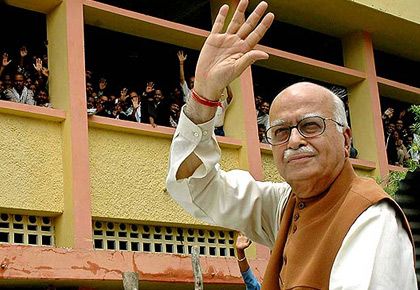Syed Firdaus Ashraf traces the trajectory of Lal Krishna Advani from the highs of the 1990s to the present, when he may have to watch the elections from the sidelines.
Presentation: Ashish Narsale/Rediff.com
↓
After the dissolution of the Janata Party government in 1977, the erstwhile Bharatiya Jana Sangh re-emerged as the Bharatiya Janata Party in 1980 under the moderate leadership of A B Vajpayee.
However, it fared badly in the 1984 Lok Sabha elections that followed, winning just two seats, with the Congress party bagging a stupendous 402 seats in the aftermath of Indira Gandhi's assassination.
Lal Krishna Advani took centrestage in the party after this, becoming its president in 1986.
Under Advani's leadership the BJP lent its weight to the Vishwa Hindu Parishad's Ram Janambhoomi movement in Ayodhya.
Advani it was who recast the party as a Hindu nationalist outfit, and abandoned the Gandhian Socialism of Vajpayee.
Advani made the Ram Janambhoomi movement the centrepoint of the BJP's electoral campaign.
In the 1989 general elections the BJP won 86 seats and agreed to support the V P Singh government from outside, along with the Left Front who too extended support to the National Front government.
In the wake of the government's acceptance of the Mandal Commission report, in September 1990 Advani launched his historic Ram Rath Yatra, criss-crossing the country to demand the construction a Ram mandir in place of the Babri masjid.
His rath yatra led to numerous Hindu-Muslim riots across India in which more than 500 people died.
Lalu Yadav, then chief minister of Bihar, arrested Advani at Samastipur in Bihar on October 23, 1990, following which the BJP withdrew support to the V P Singh government, causing its fall.
The succeeding Chandra Shekhar government, dependent on the Congress for support, also did not last long, and fresh elections were called.
In the 1991 elections, marred by former prime minister Rajiv Gandhi's assassination midway, the BJP could win only 120 seats.
The Congress, which won 244 seats, formed a minority government under P V Narasimha Rao.
The BJP's defeat came as a huge setback for Advani who resigned, making the way for Murli Manohar Joshi to succeed him.
However, Advani returned as party chief in 1993, holding on to the post till 1998.
In 1992 Advani took out another Ram Rath Yatra and went to Ayodhya to perform shilanayas at Ram Janambhoomi-Babri Masjid site.
This time Uttar Pradesh was ruled by BJP's Kalyan Singh whose government even filed an affidavit in the Supreme Court to protect Babri Masjid.
However, on December 6, 1992, kar sevaks defied the Supreme Court and demolished the masjid even as Advani and other top leaders watched in silence.
Later, Advani would characterise the day as "the darkest day" of his life, but the damage was already done.
In the 1996 general elections Advani took a backseat and made moderate Vajpayee the face of the BJP, which emerged as the single largest party.
He was also accused of Jain hawala links by the Congress government but all the charges were proved to be false in courts.
The BJP formed a minority government at the Centre under Vajpayee but bowed out in 13 days unable to prove its majority in the Lok Sabha.
In 1998, aAfter two years of United Front coalition government, the BJP formed a government with allies in a broad coalition called National Democratic Alliance, with Advani becoming the deputy prime minister to Vajpayee.
In 2001, when the Gujarat BJP government went into a crisis due to infighting, Advani sent his protégé from New Delhi, Narendra Modi, to Gandhinagar as chief minister.
Within a year of Modi's rule the Godhra train attacks takes place in which more than 50 Kar Sevaks were burnt to death.
Anti-Muslim riots followed, claiming hundreds of lives.
Pressure mounted on Prime Minister Vajpayee to oust Modi but Advani it was who saved him.
In 2004, the BJP unexpectedly lost the general election under Vajpayee and Advani once again came to the forefront by becoming its president.
In 2005 he visited Pakistan and praised Pakistan founder Mohammed Ali Jinnah, calling him secular.
In the huge row that followed in India over his comments, he resigned from his post, only to take it back.
On December 31, 2005, he resigned again, and this time Rajnath Singh took over as BJP chief.
Though Rajnath Singh was the party president it was Advani who was projected as the BJP's prime ministerial candidate in 2009.
His campaign manager? Gujarat Chief Minister Narendra Modi.
The BJP campaigned under the slogan 'Kushal Neta, Nirnayak Sarkar (Able leader, decisive government)' but it flopped badly, with the Congress actually increasing its tally over 2004.
Nitin Gadkari was then roped in by the RSS to lead BJP with Advani getting more and more sidelined in the party.
After a four-year term Gadkari is accused of financial impropriety and resigned.
Rajnath Singh again took over as BJP president and a power struggle begins in the party as to who will be its PM face in 2014.
Advani openly supports Madhya Pradesh Chief Minister Shivraj Singh Chouhan but it was Narendra Modi who found favour in the party and also from the RSS.
Modi recorded a historic win for the BJP in 2014, securing a simple majority for the BJP by winning 282 seats.
Advani wins from Gandhinagar but clearly his stars are on the wane, as it is of other senior leaders like M M Joshi.
The elders are soon relegated to the ineffective Margdarshak Mandal, and this week it became clear that with BJP chief Amit Shah replacing him in Gandhinagar, the party is over for Advani.











 © 2025
© 2025